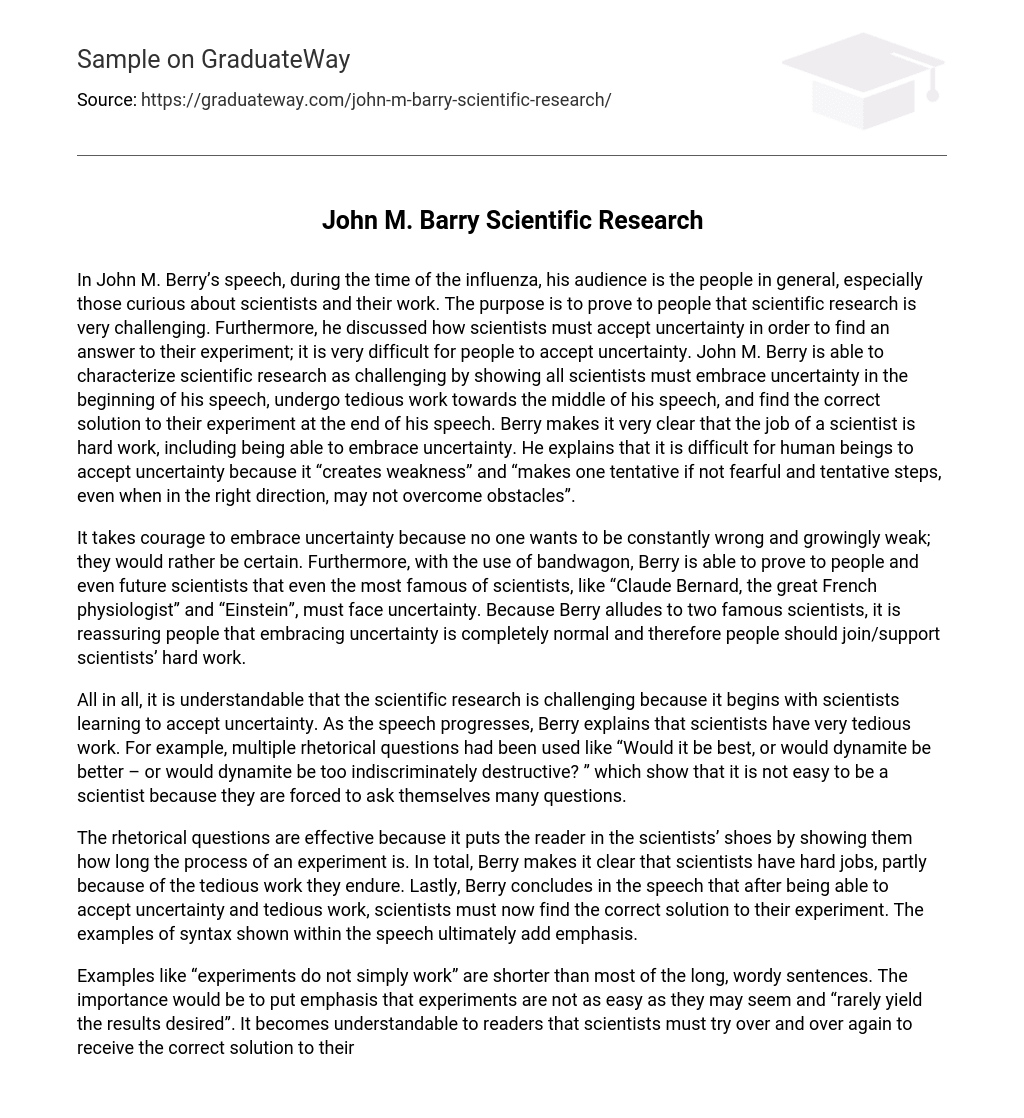In John M. Berry’s speech, during the time of the influenza, his audience is the people in general, especially those curious about scientists and their work. The purpose is to prove to people that scientific research is very challenging. Furthermore, he discussed how scientists must accept uncertainty in order to find an answer to their experiment; it is very difficult for people to accept uncertainty. John M. Berry is able to characterize scientific research as challenging by showing all scientists must embrace uncertainty in the beginning of his speech, undergo tedious work towards the middle of his speech, and find the correct solution to their experiment at the end of his speech. Berry makes it very clear that the job of a scientist is hard work, including being able to embrace uncertainty. He explains that it is difficult for human beings to accept uncertainty because it “creates weakness” and “makes one tentative if not fearful and tentative steps, even when in the right direction, may not overcome obstacles”.
It takes courage to embrace uncertainty because no one wants to be constantly wrong and growingly weak; they would rather be certain. Furthermore, with the use of bandwagon, Berry is able to prove to people and even future scientists that even the most famous of scientists, like “Claude Bernard, the great French physiologist” and “Einstein”, must face uncertainty. Because Berry alludes to two famous scientists, it is reassuring people that embracing uncertainty is completely normal and therefore people should join/support scientists’ hard work.
All in all, it is understandable that the scientific research is challenging because it begins with scientists learning to accept uncertainty. As the speech progresses, Berry explains that scientists have very tedious work. For example, multiple rhetorical questions had been used like “Would it be best, or would dynamite be better – or would dynamite be too indiscriminately destructive? ” which show that it is not easy to be a scientist because they are forced to ask themselves many questions.
The rhetorical questions are effective because it puts the reader in the scientists’ shoes by showing them how long the process of an experiment is. In total, Berry makes it clear that scientists have hard jobs, partly because of the tedious work they endure. Lastly, Berry concludes in the speech that after being able to accept uncertainty and tedious work, scientists must now find the correct solution to their experiment. The examples of syntax shown within the speech ultimately add emphasis.
Examples like “experiments do not simply work” are shorter than most of the long, wordy sentences. The importance would be to put emphasis that experiments are not as easy as they may seem and “rarely yield the results desired”. It becomes understandable to readers that scientists must try over and over again to receive the correct solution to their experiment. Furthermore, Berry wraps up by stating that “the less known, the more one has to manipulate and even force experiments to yield an answer” so that it is clear the ultimate job of a scientist is to find answers.
All in all, Berry proves that scientific research is difficult especially because scientists must have the correct solution to their experiment. In conclusion, John M. Berry is able to characterize scientific research by showing all scientists must embrace uncertainty, undergo tedious work, and find the correct solution to their experiment. Behind closed doors, scientists are working a lot harder than we believe in order to provide answers that will move us forward into our future.





